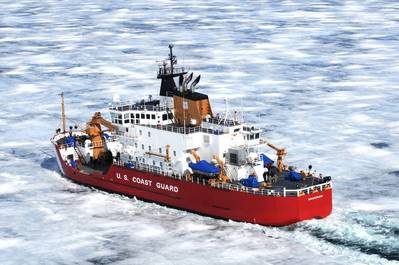Plans for a second heavy icebreaker for service on the Great Lakes have taken another step toward reality with Senator Tammy Baldwin (D-Wisc.) including $2 million for initial survey and design work for a vessel that is at least as capable as the current icebreaker Mackinaw in the committee report on the Department of Homeland Security Appropriations bill.
The Coast Guard Authorization Act of 2015 had previously authorized a new heavy icebreaker for Lakes service. Senator Baldwin’s provision would provide the first funds specifically targeted toward acquisition of a second heavy icebreaker to partner with the cutter Mackinaw commissioned in 2006.
“We applaud Senator Baldwin for her ongoing efforts to enhance the Coast Guard’s icebreaking capacity on the Great Lakes and St. Lawrence Seaway,” said Thomas Curelli, President of Great Lakes Maritime Task Force (GLMTF), the largest labor/management coalition ever assembled to promote waterborne commerce on the Fourth Seacoast. “The winters of 2014 and 2015 were so severe that jobs and business revenue lost totaled 5,800 and $1.1 billion respectively,” noted Curelli, who is also Vice President of Engineering for Fraser Shipyards.
“I am proud to partner with the Great Lakes Maritime Task Force and its members on this critically important effort,” said Senator Baldwin. “It is an honor to fight for investments that keep our Great Lakes economy open for business all year round so maritime commerce and workers can move American goods to market.”
Cargo movement during the ice season is crucial to meeting the needs of commerce. Ice can begin forming in early December and linger well into April, on occasion, into May. The cargos that move during those months can top 20 million tons, or 15-plus percent of the Lakes/Seaway’s annual total.
Iron ore for steel production and coal for power generation are the primary cargos shipped during the ice season, but limestone, salt, cement, grain, general cargo and liquid-bulk products move as well.
“The cargos that move on the Great Lakes and Seaway are the backbone of the U.S. economy,” said Brian D. Krus, 1st Vice President of GLMTF and Senior National Assistance Vice President of American Maritime Officers. “It is estimated that Lakes/Seaway shipping supports 227,000 jobs in the eight Great Lakes states and Ontario and Quebec. It is imperative that both the U.S. and Canadian Coast Guards have adequate icebreaking resources stationed on the Great Lakes.”
The U.S. Coast Guard has nine icebreakers assigned to the Great Lakes, but one is undergoing modernization at the Coast Guard yard in Baltimore. When it is ready, it will return to the Great Lakes and another vessel of its class will undergo service life extension until all of the six 140-foot-long icebreaking tugs have been modernized.
Canada has two icebreakers permanently stationed on the Lakes and brings in other assets when required.
“We cannot let the mild winter of 2015/2016 lull us into a false sense of security,” said James H.I. Weakley, 2nd Vice President of GLMTF and President of Lake Carriers’ Association. “Just 16 months ago a U.S.-flag laker with an ice-strengthened bow and 7,000 horsepower engine sat immobile within sight of land for 5 days. The Coast Guard icebreaker dispatched to the scene was unable to free the vessel and its last cargo had to be cancelled. The U.S. Coast Guard must have two heavy icebreakers in order to reliably meet the needs of commerce.”
John D. Baker, 3rd Vice President of GLMTF and President Emeritus of the ILA’s Great Lakes District Council, stressed icebreaking is critical to the St. Lawrence Seaway, even though it is closed from around January 1 to late March. “Operators of oceangoing vessels cannot risk being trapped on the Great Lakes over a winter or suffering ice damage, so will exit the system sooner than necessary or delay their first cargos of the spring if they are concerned about icebreaking resources. Inadequate icebreaking resources can effectively shorten the Seaway’s season. Again, we thank Senator Baldwin and all the Great Lakes delegation for their commitment to keeping Great Lakes and Seaway shipping safe and efficient during the ice season.”











